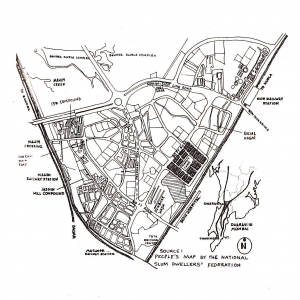
- What is Dharavi Redevelopment Project (DRP)?
The Slum redevelopment in Dharavi called the Dharavi Redevelopment Plan (DRP), is a public – private partnership project developed by private developers (Arputham & Patel 2010). The method is to divide “Dharavi into 32 sectors or units based on boundaries that the residents feel define their neighborhoods” (Arputham & Patel 2010), in which 5 sectors are selected to be the first step of the DRP.
According to “Video 1: DRP – Dharavi Redevelopment Plan”, DRP crossed 5 sectors on 216 hectares and the buildings would be constructed on 103 hectares. In the DRP, there are around 70,000 families in Dharavi benefitting from this residential, commercial, and industrial construction project. Moreover, there are around 35,000-40,000 houses available for sale to the middle class. The DRP benefits the whole working class in the city, thus it is not restricted to the residents in Dharavi.
Video 1:
2. Why is it important to the city?
Dharavi is the largest and and most known slum in India, a fast developing nation. Therefore, the process of gentrification acts as a medium to transform their perceived identity into the aesthetics of a world city. Before the implementation of DRP, there were no developers interested in Dharavi. Only 15% of the area had been developed in the past 12 years. This highlights the importance of DRP as a necessary process for Mumbai’s future.
 (Lamarca 2010)
(Lamarca 2010)
3. Problems with the DRP
The Dharavi’s residents originally supported the redevelopment process, such that 70 percent of the population agreed to the redevelopment (Patel and Arputham, 2008). However, the project was postponed because of the absence of the community participation and the dereliction of the duty of local government in DRP. Patel and Arputham (2008) also point out that the DPR would essentially benefit the developers and government but not the squatters, which would deviate the purpose of the project (Patel & Arputham 2008).
Video 2:
https://www.youtube.com/watch?v=gYa6ooID1ZE
The residents from claimed that the institutions had never surveyed nor asked for the residents’ opinions regarding the DRP, instead, they had directly declared the residents’ agreement to the plan (Patel & Arputham 2008). The failure of the plan is then manifest through the dispossession of more than 50,000 families. In addition, the residents were promised with houses more than 400 square foot after the redevelopment, but instead were only given 269 square foot; moreover, the DRP had agreed to provide public institutions such as schools and health centers, but there was no transparency provided to explain how the institutes would be developed nor was there any mention on how it would be made affordable to the peoples most affected (Patel & Arputham 2008).
Reference
Arputham, J., & Patel, S. (2010). Recent developments in plans for Dharavi and for the airport slums in Mumbai. Environment & Urbanization, 22(2), pp. 501-504.
Lamarca, M.C., (2010). Contested Urbanism: Reclaiming the Right to the City in Dharavi. (2010, April 14). [Image]. Retrieved March 30, 2017, from at: http://www.thepolisblog.org/2010/04/contested-urbanism-reclaiming-right-to.html
Org. P, (2014). DRP – Dharavi Redevelopment Plan. Available at: https://www.youtube.com/watch?v=-eszv0xan8E [Accessed 30 Mar. 2017].
Patel, S., & Arputham, J. (2008). Plans for Dharavi: Negotiating a reconciliation between a state-driven market redevelopment and residents’ aspirations. Environment & Urbanization, 20(1), pp. 243-253.
StanleyFoundation, (2009). Dharavi Slum Rehabilitation. Available at: https://www.youtube.com/watch?v=gYa6ooID1ZE [Accessed 30 Mar. 2017].